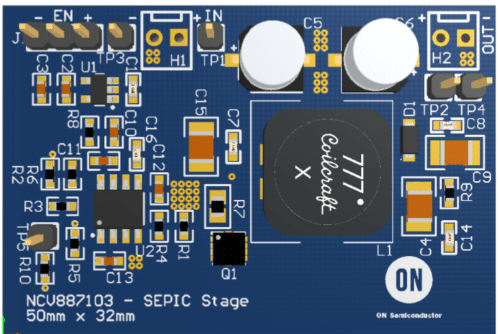The SEPIC reference solution streamlines automotive rear lighting design, ensuring stable voltage regulation and robust performance across input voltages.

The Single-Ended Primary Inductor Converter (SEPIC) stands out as a crucial power conversion topology in the rapidly evolving automotive electronics landscape. Its unique ability to efficiently manage a wide range of input voltages while maintaining a stable output voltage addresses modern vehicles’ diverse and demanding power requirements. SEPIC converters are essential for ensuring the reliable operation of sensitive automotive electronics, enhancing energy efficiency, and providing robust protection features. Their versatility and efficiency make them indispensable in applications such as LED lighting, battery management, and infotainment systems, underpinning the performance and safety of contemporary automotive technology. TND6344/D, a reference design of automotive SEPIC by Onsemi, simplifies the design process.
This design is specifically tailored for automotive rear lighting applications using the SEPIC topology. It ensures efficient power management and stable voltage regulation, which is critical for the reliable operation of rear lighting systems. The SEPIC controller handles the wide input voltage range typical in automotive environments, providing consistent performance and enhancing the safety and visibility of the vehicle’s rear lighting. It showcases the controller’s capabilities and provides a comprehensive design for an automotive pre-regulator suitable for a wide range of applications.
Power supply designers can integrate this circuit directly into typical system designs with minimal component adjustments based on specific system requirements. The design serves as a complete solution while also providing access to critical features of the NCV887103. These features include peak current mode control with internal slope compensation, 1.2 V ±2% reference voltage, fixed frequency operation, a wide input voltage range, input Undervoltage lockout, internal soft start, low IQ in sleep mode, cycle-by-cycle current limit protection, hiccup-mode overcurrent protection, hiccup-mode short-circuit protection, and thermal shutdown.
The design’s key features include a comprehensive automotive reference design utilizing a non-synchronous SEPIC controller with an input voltage range of 6.0 V to 16.0 V, capable of handling peaks up to 40 V. It operates at a switching frequency of 340 kHz for maximum efficiency. The design incorporates the ON Semiconductor NCV887103 adjustable output automotive non-synchronous SEPIC controller and the NVTFS5C478NL 40 V single N-channel FET. Additionally, it features a small form factor PCB with two layers, making it compact and suitable for various automotive applications.
Onsemi has tested this reference design. It comes with a bill of materials (BOM), schematics, assembly drawing, printed circuit board (PCB) layout, and more. The company’s website has additional data about the reference design. To read more about this reference design, click here.










